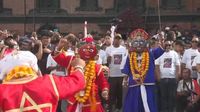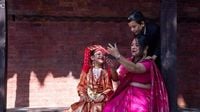The heart of Kathmandu pulsed with life and devotion on Saturday, September 6, 2025, as tens of thousands of people gathered to mark the opening of Nepal’s vibrant festival season. The old palace, a centuries-old landmark in the capital, was packed to the brim as families, officials, and tourists alike came together to witness the start of the weeklong Indra Jatra festival—a tradition steeped in history, myth, and community spirit.
According to the Associated Press, the Indra Jatra festival is the first in a series of major celebrations that will sweep across the predominantly Hindu nation in the coming months. Dasain, Nepal’s main festival, is set to follow later in September, while Tihar—also known as Diwali, the festival of lights—will illuminate the country in October. But it’s Indra Jatra that sets the tone, blending religious fervor, cultural spectacle, and an unmistakable sense of unity.
On this opening day, the city’s narrow, winding streets overflowed with devotees. Men and boys, clad in colorful masks and ornate gowns representing a pantheon of Hindu deities, danced to the hypnotic rhythms of traditional music and drums. The air was thick with the scent of incense as families lit offerings at shrines, honoring ancestors and seeking blessings for the months ahead. In a scene both timeless and electric, the festival’s pageantry played out before a crowd that included Nepal’s president, prime minister, and several top officials, all lining up to pay their respects.
At the center of the celebration was a tradition that has captivated both locals and visitors for generations: the procession of the Kumari, or living goddess. Revered by both Hindus and Buddhists, the Kumari is a young girl chosen from the Newar community—the native residents of Kathmandu—and is believed to embody divine power. She was paraded through the city atop a wooden chariot, her serene expression and regal attire drawing waves of awe and devotion from the throngs below.
As reported by AP video journalist Upendra Man Singh, the Indra Jatra festival marks not just a religious occasion but also a pivotal moment in Nepal’s agricultural calendar. It signals the end of the monsoon rains and the completion of the rice farming season, ushering in the crisp air and golden hues of fall. For the Newars, who have called Kathmandu home for centuries, Indra Jatra is more than a festival—it’s a living tapestry of heritage, community, and faith.
“The masked dancers are one of the highlights of the ceremony,” noted a local attendee. “They can be fearsome, entertaining, and awe-inspiring, depending on the performers’ movements.” Indeed, the dancers—some playing deities, others demons—move with a blend of athleticism and artistry, their performances evoking tales of gods and legends that have been passed down through generations.
The festival’s namesake, Indra, is the Hindu god of rain, and his blessings are invoked by the community as they give thanks for the harvest and pray for prosperity in the year ahead. Yet, Indra Jatra is also a celebration of Kathmandu’s unique blend of Hindu and Buddhist traditions, a reflection of Nepal’s rich religious mosaic. The presence of the Kumari, who is honored by both faiths, underscores this spirit of inclusion and reverence.
The spectacle of the Kumari’s chariot winding through Kathmandu’s ancient lanes is a sight to behold. Devotees line up for hours—sometimes all day—hoping to catch a glimpse of the living goddess and receive her blessing. According to the Associated Press, the crowd this year was especially large, with tens of thousands braving the September heat and jostling for position along the parade route. The city’s old palace, normally a stately reminder of Nepal’s royal past, became the stage for a living drama that connects the present to the past.
But Indra Jatra is only the beginning. The festival season in Nepal is a marathon of celebration, with Dasain and Tihar following in quick succession. Dasain, often described as the country’s main festival, is a time for family reunions, animal sacrifices, and the exchange of blessings. Tihar, or Diwali, brings a different energy—one of lights, music, and the honoring of animals such as crows, dogs, and cows, each with their own symbolic significance. Together, these festivals form the heartbeat of Nepalese cultural life, binding communities and generations.
This year’s Indra Jatra felt especially poignant. After years marked by political uncertainty and the lingering effects of the pandemic, the festival offered a moment of collective joy and reflection. For many, it was a chance to reconnect with tradition, to honor ancestors, and to look forward with hope. The presence of national leaders among the crowd was not lost on the public, signaling a sense of unity and shared purpose at a time when the country faces both opportunities and challenges.
“It’s amazing to see everyone come together like this,” said one festival-goer, her face painted and her arms full of flowers and offerings. “No matter what’s happening in the world, these festivals remind us of who we are and what we share.”
For the Newar community, Indra Jatra is a cornerstone of identity. The festival’s rituals, dances, and processions are carefully preserved, passed down through families and community groups. The masked dancers, some of whom train for months, are both performers and keepers of tradition, ensuring that the stories and values of their ancestors endure.
As the sun set over Kathmandu, the city’s temples and shrines glowed in the warm light, incense curling into the evening sky. The sounds of drums and laughter echoed through the streets, a reminder that, for all its changes, Nepal remains a land where the sacred and the everyday are deeply intertwined.
With Indra Jatra underway, anticipation now builds for the next chapters of Nepal’s festival season. Dasain and Tihar promise more gatherings, more rituals, and more moments of shared celebration. For now, though, Kathmandu’s old palace stands as a testament to the enduring power of tradition—and the living goddess who, for one magical week, leads her people into a season of hope and renewal.


